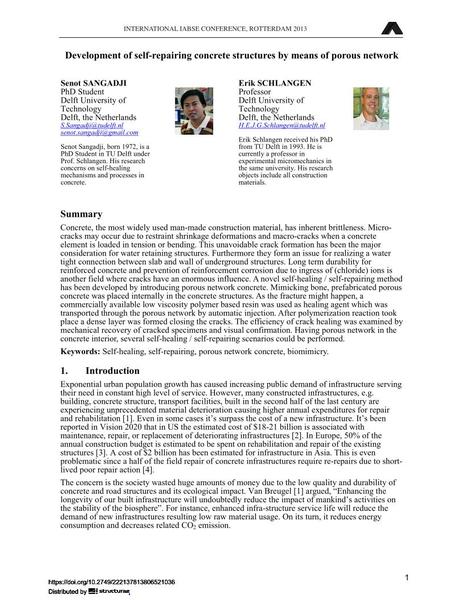Development of self-repairing concrete structures by means of porous network

|
|
|||||||||||
Détails bibliographiques
| Auteur(s): |
Senot Sangadji
Erik Schlangen |
||||
|---|---|---|---|---|---|
| Médium: | papier de conférence | ||||
| Langue(s): | anglais | ||||
| Conférence: | IABSE Conference: Assessment, Upgrading and Refurbishment of Infrastructures, Rotterdam, The Netherlands, 6-8 May 2013 | ||||
| Publié dans: | IABSE Conference, Rotterdam, May 2013 | ||||
|
|||||
| Page(s): | 460-461 | ||||
| Nombre total de pages (du PDF): | 8 | ||||
| Année: | 2013 | ||||
| DOI: | 10.2749/222137813806521036 | ||||
| Abstrait: |
Concrete, the most widely used man-made construction material, has inherent brittleness. Micro- cracks may occur due to restraint shrinkage deformations and macro-cracks when a concrete element is loaded in tension or bending. This unavoidable crack formation has been the major consideration for water retaining structures. Furthermore they form an issue for realizing a water tight connection between slab and wall of underground structures. Long term durability for reinforced concrete and prevention of reinforcement corrosion due to ingress of (chloride) ions is another field where cracks have an enormous influence. A novel self-healing / self-repairing method has been developed by introducing porous network concrete. Mimicking bone, prefabricated porous concrete was placed internally in the concrete structures. As the fracture might happen, a commercially available low viscosity polymer based resin was used as healing agent which was transported through the porous network by automatic injection. After polymerization reaction took place a dense layer was formed closing the cracks. The efficiency of crack healing was examined by mechanical recovery of cracked specimens and visual confirmation. Having porous network in the concrete interior, several self-healing / self-repairing scenarios could be performed. |
||||
